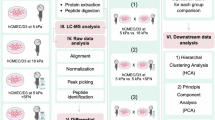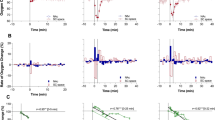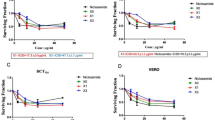Abstract
THE mechanism of the toxic effects of hyperbaric oxygen has long been a subject of discussion and Haugaard1 has summarized the evidence in favour of the view that the toxicity is due to oxidation of sulphydryl groups. More recently, however, Chance et al.2 observed that 11–17 atm. of oxygen selectively inhibit the energy-linked reduction by succinate of nicotinamide-adenine dinucleotide (NAD). Because this inhibition occurs much more rapidly than oxidation of sulphydryl groups, Chance et al. suggested the energy-linked reduction of NAD by succinate as the site of the toxic effects of hyperbaric oxygen. The oxygen pressures used by Chance, however, were much greater than those customarily used therapeutically3—that is 3 atm. Because toxicity is also observed at these pressures, it seemed desirable to examine the effects of oxygen at 3 atm. on the energy-linked reduction of NAD by succinate.
This is a preview of subscription content, access via your institution
Access options
Subscribe to this journal
Receive 51 print issues and online access
$199.00 per year
only $3.90 per issue
Buy this article
- Purchase on SpringerLink
- Instant access to full article PDF
Prices may be subject to local taxes which are calculated during checkout
Similar content being viewed by others
References
Haugaard, N., Ann. NY Acad. Sci., 117, 736 (1965).
Chance, B., Jamieson, D., and Coles, H., Nature, 206, 257 (1965).
Hyperbaric Oxygenation (edit. by Ledingham, McA.), 1, Sect. 1 (E. and S. Livingstone, Ltd., 1965).
Tager, J. M., and Slater, E. C., Biochim. Biophys. Acta, 77, 246 (1963).
Boerema, I., in Hyperbaric Oxygenation (edit. by Boerema, I., Brummel-kamp, W. H., and Meyne, N. G.), 1 (1964).
Myers, D. K., and Slater, E. C., Biochem. J., 67, 558 (1957).
Bernt, E., and Bergmeyer, H. U., in Methods in Enzymatic Analysis (edit. by Bergmeyer, H. U.), 384 (Academic Press, New York, 1963).
Papa, S., Tager, J. M., Francavilla, A., de Haan, E. J., and Quagliariello, E., Biochim. Biophys. Acta, 131, 14 (1967).
Author information
Authors and Affiliations
Rights and permissions
About this article
Cite this article
STRAUB, J. Mechanism of the Toxic Effects of Hyperbaric Oxygen. Nature 215, 1196 (1967). https://doi.org/10.1038/2151196a0
Received:
Issue date:
DOI: https://doi.org/10.1038/2151196a0



